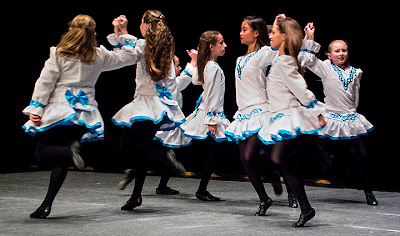 |
| For me, the little dancer in the middle of the image makes the picture. |
I think of my Fuji FinePix HS10 as a glorified point and shoot. It appears, at first glance, to be small version of a DSLR but it is more illusion that fact. Oh, it has some nice features, I love the manually controlled zoom. It works just like my professional zoom lenses from my days as a newspaper shooter. But the oh-so-slow lens is a killer — a picture killer.
If you are like me, too poor to afford a complete DSLR kit, a couple of point and shoots can work just fine but you have to make some concessions. You've got to accept that you will have a high failure rate when it comes to taking pictures under difficult conditions.
Something that most folk forget is that action is not constant. If dancing girls are hopping about a stage, there is a moment when they are neither hopping up nor down. Action stops while the direction of the action reverses. Capture this peak moment and even a slow shutter speed will yield a picture.
Capturing the peak moment is easier said than done. I find with my HS10 that if I use the continuous shooting mode I increase my chances of hitting this action-capturing sweet spot.
Link the use of the continuous shooting mode with shooting moments when action has actually stopped is an even better way of guaranteeing an image. For instance, with the dancers there was a moment at the end of every reel or jig when the girls took a pose before bounding off stage. These poses made for perfect moments for maximizing the chance of capturing a quality photo.
One nice thing about posed shots is the quality; It is good enough quality to make acceptable prints. When images are presented online, they do not need the resolution demanded by images being made into prints.
If you are sacrificing movement in order to get a good image, watch for images with other features that can give the picture visual punch. Colour is a good thing to watch for. Splashes of colour almost always add to the appearance of a picture on a page.
Shooting a dance performance, inside on a stage, can be difficult when using a point and shoot. But, it is not an impossible situation. But, if there is one dancer, a daughter or granddaughter that you simply must have in a picture, go for the posed shot.












